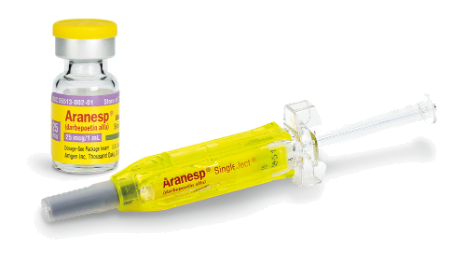
Mean change in Hb from baseline to evaluation

More than

Patients have received
ARANESP® since FDA approval3,†
*Data from a multicenter, randomized, open-label study comparing epoetin, given 1, 2, or 3 times weekly IV or SC, with ARANESP®, at a reduced dose frequency, in dialysis patients (N = 522). Dose adjustments were made as necessary and per study protocol to maintain individual patients’ Hb within a target range of –1.0 to +1.5 g/dL of their baseline Hb and between 9 g/dL and 13 g/dL for up to 52 weeks. The primary endpoint was the change in Hb between baseline and the evaluation period at weeks 25 to 32 of treatment. The mean change in Hb from baseline to the evaluation period was similar in the ARANESP® and epoetin groups, and the difference between the two treatment groups was 0.03 g/dL. This was not a statistically significant or clinically relevant difference. 97% (178/183) of patients’ Hb levels were successfully maintained on ARANESP® QW or less after conversion from epoetin during the evaluation period.2
†In the postmarketing setting from launch through December 31, 2020. The number of patients exposed are based on sales revenue data and include both nephrology and oncology patients.
‡Cumulative estimate based on subjects who received ≥ 1 dose (actual exposure) for completed clinical studies from launch through October 2024. There were no additional ongoing or completed studies since October 2018.
FDA = Food and Drug Administration;

ARANESP® is also available in 150, 200, 300, and 500 mcg dose strengths. ARANESP® is available in single-dose vials and prefilled syringes, except the 10, 150, 300, and 500 mcg dose strengths, which are available only as prefilled syringes.
The IV route of administration is recommended for adult patients on hemodialysis.
The molecular structure of ARANESP® provides extended erythropoietic activity that allows for QW and Q2W dosing intervals5,6
Q2W = once every two weeks.


You can more precisely titrate doses and individualize anemia management for patients with CKD on dialysis.
With the 10 mcg dose strength, doses can be precisely titrated within 5 mcg intervals.4,*
*Except the 15 mcg dose.

Instructions for Use 
HD = hemodialysis; PD = peritoneal dialysis.
Following initiation of therapy and after each dose adjustment, monitor Hb at least weekly until the Hb is stable and sufficient to minimize the need for RBC transfusion.
Q4W = once every 4 weeks.
When adjusting therapy, consider Hb rise, rate of decline, ESA responsiveness, and Hb variability.
If Hb rises rapidly (eg, more than 1 g/dL in any 2-week period), reduce the dose by 25% or more, as needed, to reduce rapid responses.
FOR ADULT PATIENTS WITH CKD:
FOR PEDIATRIC PATIENTS (LESS THAN 18 YEARS) WITH CKD:
Patients with CKD and an insufficient Hb response to ESA therapy or a rate of Hb rise of > 1 g/dL over 2 weeks may be at an even greater risk for cardiovascular reactions and mortality than other patients.
| PREVIOUS EPOETIN ALFA DOSE (units/week) |
QW ARANESP® STARTING DOSE
Adult (mcg/week)
Child(mcg/week)
|
|
| < 1500 | 6.25 | * |
| 1500 to 2499 | 6.25 | 6.25 |
| 2500 to 4999 | 12.5 | 10 |
| 5000 to 10,999 | 25 | 20 |
| 11,000 to 17,999 | 40 | 40 |
| 18,000 to 33,999 | 60 | 60 |
| 34,000 to 89,999 | 100 | 100 |
| ≥ 90,000 | 200 | 200 |
The dose conversions depicted above do not accurately estimate the once-monthly dose of ARANESP® in patients with CKD not on dialysis.
Remember to convert your patient’s previous epoetin alfa per-administration dose to a per-week
measurement. Here’s an example of an adult
patient1:
| PREVIOUS EPOETIN ALFA DOSE | ADULT ARANESP® STARTING DOSE | |
| Per administration | Per week | QW |
| 3000 units/administration | x 3 = 9000 units/week | 25 mcg |
| 4000 units/administration | x 3 = 12,000 units/week | 40 mcg |
*For pediatric patients receiving a weekly epoetin alfa dose of < 1500 units/week. The available data are insufficient to determine an ARANESP® conversion dose.
97% of patients maintained Hb on ARANESP® post-conversion2

DCR = dose conversion ratio.
References:
ARANESP® (darbepoetin alfa) Important Safety Information, including Boxed WARNINGS
WARNING: ESAs INCREASE THE RISK OF DEATH, MYOCARDIAL INFARCTION, STROKE, VENOUS THROMBOEMBOLISM, THROMBOSIS OF VASCULAR ACCESS AND TUMOR PROGRESSION OR RECURRENCE
Chronic Kidney Disease:
Cancer:
Please see ARANESP® full Prescribing Information, including Boxed WARNINGS and Medication Guide.

ARANESP® (darbepoetin alfa) Important Safety Information, including Boxed WARNINGS
WARNING: ESAs INCREASE THE RISK OF DEATH, MYOCARDIAL INFARCTION, STROKE, VENOUS THROMBOEMBOLISM, THROMBOSIS OF VASCULAR ACCESS AND TUMOR PROGRESSION OR RECURRENCE
Chronic Kidney Disease:
Cancer:
Please see ARANESP® full Prescribing Information, including Boxed WARNINGS and Medication Guide.